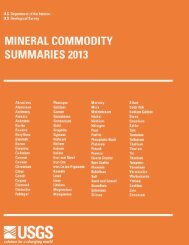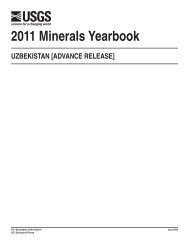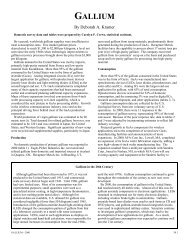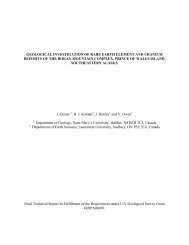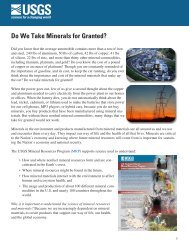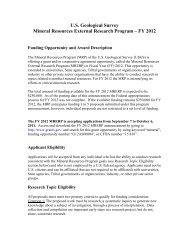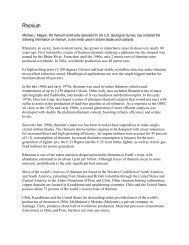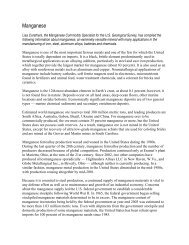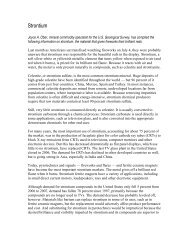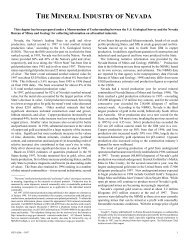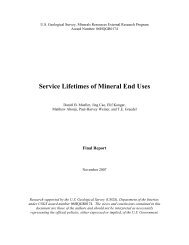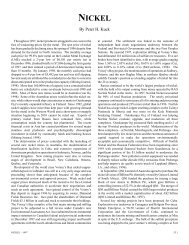Mineral Commodity Summaries 2003 - Mineral Resources Program ...
Mineral Commodity Summaries 2003 - Mineral Resources Program ...
Mineral Commodity Summaries 2003 - Mineral Resources Program ...
You also want an ePaper? Increase the reach of your titles
YUMPU automatically turns print PDFs into web optimized ePapers that Google loves.
THALLIUM<br />
Events, Trends, and Issues: Research and development activities of both a basic and applied nature were<br />
conducted during 2002 to improve and expand the use of thallium. These activities included the development of hightemperature<br />
superconducting materials for such applications as magnetic resonance imaging, storage of magnetic<br />
energy, magnetic propulsion, and electric power generation and transmission. Consideration continued to be given to<br />
the use of a thallium-oxide superconductor as a material for such applications. The development of improved<br />
methods for synthesizing high-temperature superconductors, such as thallium cuprates, also received attention during<br />
the year. Further use of radioactive thallium in clinical diagnostic applications, including cardiovascular and<br />
oncological imaging, also was studied during 2002. One such study involved the use of a thallium radiation technique<br />
to assess the therapeutic response to a particular type of oncological treatment.<br />
Thallium metal and its compounds are highly toxic materials and are strictly controlled to prevent a threat to humans<br />
and the environment. Thallium and its compounds can be absorbed into the human body by skin contact, ingestion, or<br />
inhalation of dust or fumes. In 2002, the U.S. Environmental Protection Agency initiated health assessments on<br />
thallium and several other metals and chemicals for inclusion in the agency’s Integrated Risk Information System data<br />
base. Information from the public was requested in making the assessments. The U.S. Department of Transportation<br />
issued a proposed rule that would amend its requirements for the safe transport of radioactive materials, including<br />
thallium, to make them compatible with international requirements.<br />
World Mine Production, Reserves, and Reserve Base: 5<br />
Mine production Reserves 6<br />
Reserve base 6<br />
2001 2002<br />
United States ( 7 ) ( 7 ) 32,000 120,000<br />
Other countries 15,000 15,000 350,000 530,000<br />
World total (may be rounded) 15,000 15,000 380,000 650,000<br />
World <strong>Resources</strong>: World resources of thallium contained in zinc resources total about 17 million kilograms; most are<br />
located in Canada, Europe, and the United States. An additional 630 million kilograms is in world coal resources. The<br />
average thallium content of the Earth’s crust has been estimated at 0.7 part per million.<br />
Substitutes: While other light-sensitive materials can substitute for thallium and its compounds in specific electronic<br />
applications, ample supplies of thallium discourage development of substitute materials.<br />
e<br />
Estimated. NA Not available. — Zero.<br />
1<br />
Unwrought; waste and scrap; powders, including thallium contained in compounds.<br />
2<br />
Estimated price of 99.999%-pure granules in 100-gram lots.<br />
3<br />
Defined as imports - exports + adjustments for Government and industry stock changes.<br />
4<br />
By the North American Free Trade Agreement, there is no tariff for Canada or Mexico.<br />
5<br />
Estimates are based on thallium content of zinc ores.<br />
6<br />
See Appendix C for definitions.<br />
7<br />
Thallium contained in mined base-metal ores, estimated at 450 to 500 kilograms per year, is separated from the base metals but not extracted for<br />
commercial use.<br />
173<br />
U.S. Geological Survey, <strong>Mineral</strong> <strong>Commodity</strong> <strong>Summaries</strong>, January <strong>2003</strong>



